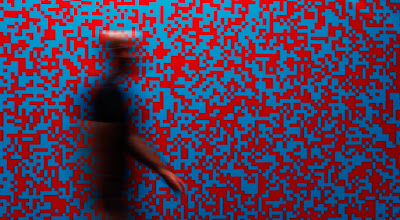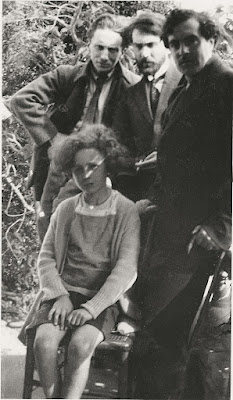ELECTRIC DREAMS at the TATE MODERN on the 30th of May 2025
ELECTRIC DREAMS at the TATE MODERN on the 30th of May 2025

Eduardo Kac, Horny, 1985. Tate. Lent by the Tate Americas
Foundation, courtesy of the Latin American Acquisitions Committee 2018 ©
Eduardo Kac
This is an exhibition
bound to connect generations. Adults and
children were present, all enjoying the interactive mysteries on display.
Electric Dreams connects
the analogue era to our own digital time, it also references the song Together in Electric Dreams, co-written by Phillip Oakey and Giorgio Moroder in 1984.
Briefly, in the not-too-distant past, meaning the 1980s, there were four
TV channels, broadsheet newspapers, telephone booths that worked, there were no
mobile phones, and people still wrote and posted letters. The exhibition is set during this time,
presenting the interface between art, science and technology as it was
understood before the advent of the internet.
 |
Harold cohen, AARON #1 Drawing, 1979. Tate, Purchased 2015. Photo courtesy of Harold Cohen Trust © Harold Cohen
Pioneers of art and technology like the Korean Nam June Paik (1932-2006) and art and magnetism like Greek artist Takis (real name Panayiotis Vassilakis (1925-2019), find their inevitable place here. In fact, Tate Modern has presented recent retrospectives of both artist’s work.
 |
| Hiroshi Kawano, KD 29 - Artificial Mondrian, 1969. © Hiroshi Kawano, Photo, ZKM Center for Art and Media Karlsruhe |
The evolution of computing from the first computers designed by Charles Babbage in the nineteenth century to the development of computing after WW2, is a dominant theme. After WW2 access to technology was restricted and only slowly began to be accessed throughout society. Its application by artists to the cause of discovering new ordering principles for their art, and the proliferation of technology which was beginning to leave the hands of the military and governmental agencies like NASA to be used by artists and creators, is a major theme of this exhibition. After WW2 computers were the size of entire rooms (like the IBM 7094 also used in the Apollo moon landings) but they gradually became miniaturized, especially as semi-conductor technology became increasingly sophisticated. Their powers also increased, bringing about the possibility of computer-generated art (which is now a reality in this era of artificial intelligence). Early computer programs like FORTRAN began to generate code that was then used to construct artworks. Computer cards with holes punched in them providing code are referenced in the exhibition as is FORTRAN and other early developments in information technology. Group shows like Cybernetic Serendipity ran at the Institute of Contemporary Art (ICA) in London in 1968 went beyond the visual arts to consider music, dance and poetry. Of course, today there are so many more possibilities, MS Copilot and Chat GPT are two examples.
,%201966.%20Courtesy%20Annely%20Juda%20Fine%20Art,%20London.jpg) |
| Katsuhiro Yamaguchi, Fujitsubo (Barnacle), 1966. Courtesy Annely Juda Fine Art, London |
Manipulation of the image
is a prevalent sub-text, being defined in our era as ‘fake news’ is seen here
as something essentially liberatory, offering us the possibility to interact,
alter, interpret, add to and not be the unwilling and unwitting participant in
passive consumption of texts and images.
 |
|
Lillian
Schwartz, Still from Enigma, 1972. Film, 4m 5s. From the Collections
of The Henry Ford. © The Henry Ford |
Dissemination of artworks is another sub theme, photocopying being treated as a revolutionary means of popularizing the work of minorities, not just as something infra dig. Video technology and computer science are yoked together following the pioneering work of US scientist Norbert Weiner on cybernetics. Thus, the question is raised, is a dialogue with the machines possible?
 |
Marina Apollino, Dinamica Circolare 6S+S, 1966. Tate. Presented
by the artist 2024. Photo courtesy the artist
Installations and electronic artworks became a preoccupation of the Beat poets such as Brion Gysin whose work The Dreammachine is featured in the exhibition. A friend of William S Burroughs, Gysin pioneered the cut-up method made famous by Burroughs in works like The Soft Machine and The Naked Lunch. The Dreammachine is a revolving kaleidoscope of light which Gysin believed was best viewed with one’s eyes shut. The work is banal by today's standards but underlines the interest shown in electronic devices by the Beat poets and the counterculture generally. Gysin also pioneered 'permutated' poems capable of being arranged in various ways to divulge a variety of meanings.
,%202005-2017,%20installation%20view,%20Atkinson%20Museum,%20Porto%202023.%20%C2%A9%20Otto%20Piene%20Estate%20DACS%202024%20%5B...%5D.JPG) |
| Otto Piene, Light Room (Jena), 2005 / 2017, installation view, Atkinson Museum, Porto 2023. © Otto Piene Estate / DACS 2024. Photo Atkinson Museum |


Comments